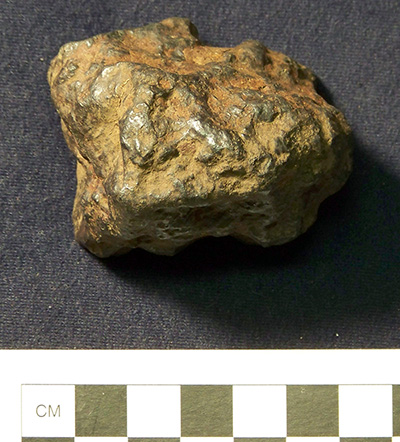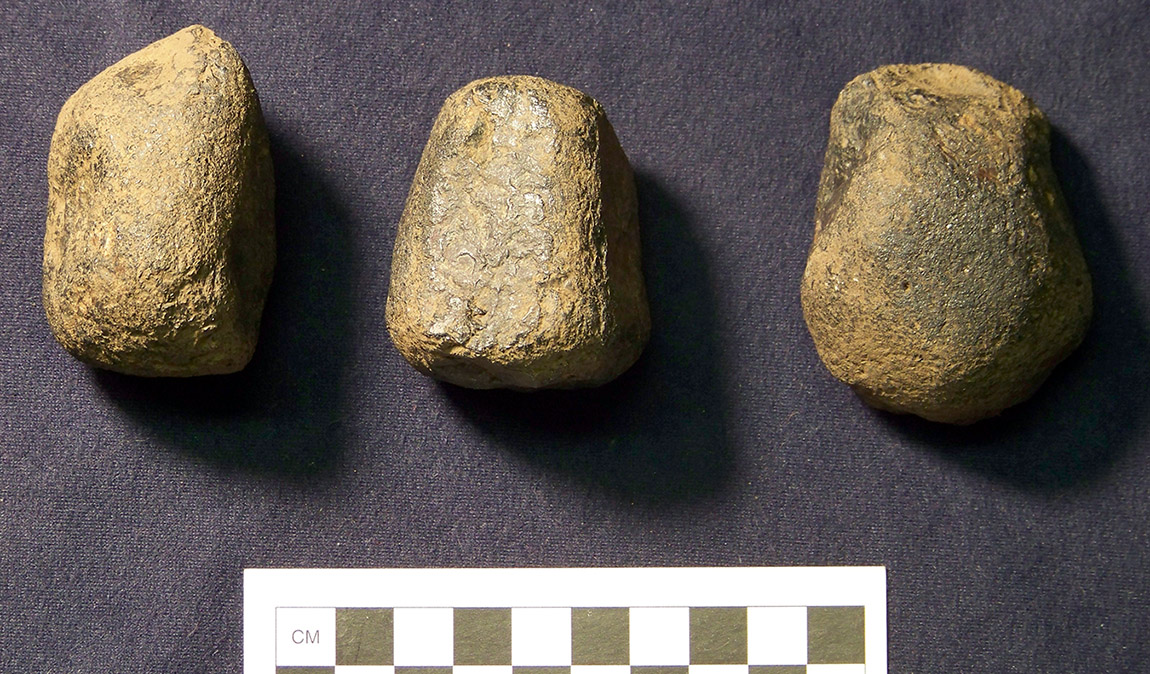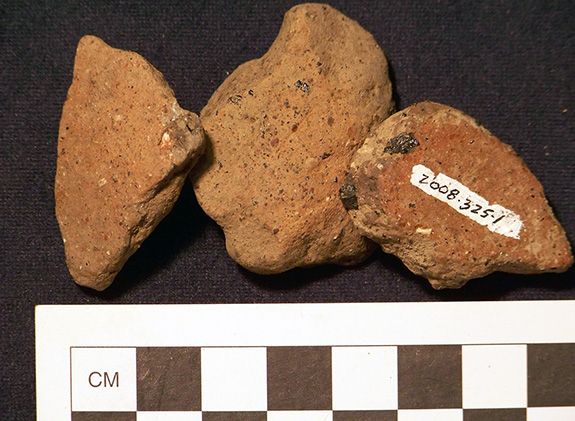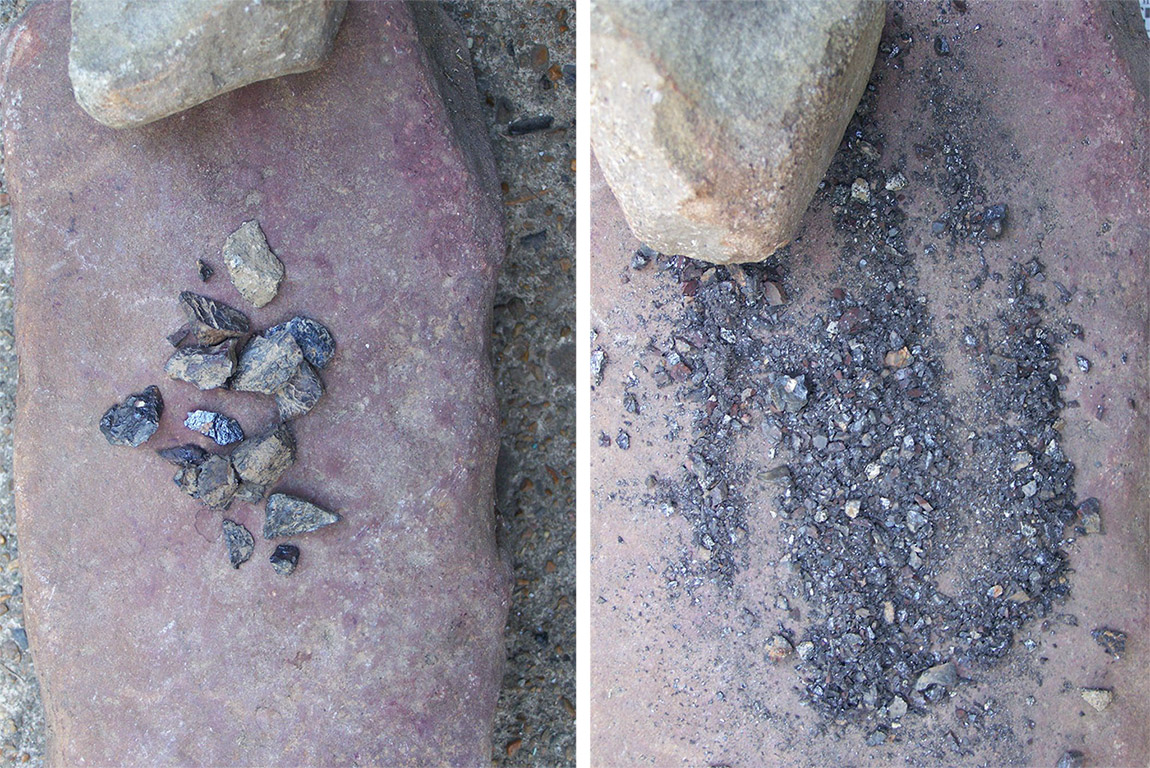Mary Beth Trubitt
Arkansas Archeological Survey-Henderson State University Research Station
One of the more unusual materials found during Society Training Program excavations at the Jones Mill site (3HS28) is magnetite, a heavy magnetic iron oxide that forms in igneous rocks in the vicinity of Magnet Cove, Arkansas. Chunks of magnetite were common in upper deposits at the site, postdating the Middle Archaic stratum. Experimental replication helps differentiate natural chunks from pieces of worked magnetite. While we did not identify any preforms for Poverty Point style net weights, I did find that magnetite was used as temper in some Woodland period ceramic sherds.
I directed Society Training Program and field school excavations at Jones Mill in 2007 and 2008. The project investigates the manufacture and trade of novaculite chipped stone tools particularly during the Middle Archaic period (ca. 6000 – 3000 BC). Following the two field seasons, over half a million pieces of novaculite tools and chipping debris were catalogued, we obtained four radiocarbon dates that establish the dating of the Middle Archaic, Woodland, and Caddo components at the site, and we reconstructed foodways based on archaeobotanical and zooarchaeological analyses (Etchieson and Trubitt 2013; Trubitt 2009, 2019; Trubitt et al. 2011).
Over 1500 pieces of magnetite were catalogued from excavations at Jones Mill, weighing nearly 180 kg (almost 400 lbs). The distribution spatially is skewed towards the western part of the site (Trenches 2, 3, and 4). The majority of magnetite pieces came from the upper two strata (plow zone and hardpan) in those trenches, above and postdating the Middle Archaic zone (Stratum III). The vertical distribution of magnetite mimics that of ceramic sherds, which were found only in the upper strata.
Geologically, magnetite is an iron oxide mineral that forms in igneous rock. It is heavy and dense, and magnetic (the term “lodestone” is sometimes used for the highly magnetic magnetite that attracts iron filings). Magnetite is just one of many unusual rocks and minerals found in the Magnet Cove area of Hot Spring County.




Archeologically, magnetite is typically associated with Late Archaic period (ca. 1700-600 BC) plummets found at the Poverty Point site in northeastern Louisiana. Magnetite is one of several nonlocal raw materials found at Poverty Point and contemporary sites in southeast Arkansas that could have come from the Ouachita Mountains region (Jeter and Jackson 1994; Webb 1977). Similar objects were found at the Woodland period Plum Bayou site outside Little Rock (Rolingson and Howard 1997). Was magnetite from Jones Mill traded to other communities during the Late Archaic or Woodland periods? We found no drilled or grooved pieces of magnetite at Jones Mill that were finished or partially finished plummets.
I decided to do some experimental replication to compare with the magnetite at Jones Mill. Most pieces appear to be unworked. Instead, they have a cortex or weathered surface all over, either rounded or angular because of past breaks. Occasionally there are facets on a piece, similar to that experimentally produced by grinding or smoothing on a sandstone slab. There are some examples that look similar to an experimentally battered piece. Most of the pieces I identified as worked have battered surfaces, while a few have striations, faceting, chipping, and smoothing. Several pieces may have been used as hammerstones. If the Late Archaic residents of Jones Mill were sending magnetite down the Ouachita River to Poverty Point, it was in raw or cobble form rather than as partly or finished plummets.
Perhaps people used magnetite to hold the heat of the fire in hearths or earth ovens. What does heated magnetite look like? I did a baking experiment, but did not notice a visible difference other than a little reddening on the exterior surface. The magnetite did not fracture from the heat, and it seemed to hold the heat for a long time.


Magnetite was used as temper in some ceramic sherds at the Jones Mill site. The majority of ceramic sherds from Jones Mill were tempered with grog or a grit-grog mixture, with shell and bone occurring in a minority of them. Sherds with a grit-grog mixture range from grog-tempered sherds with occasional pieces of grit (quartz, novaculite, or hematite), to those heavily tempered with grit. There are also sherds that were exclusively tempered with grit, specifically with a mica-magnetite mixture. These can be typed as Ouachita Ironware, a Fourche Maline or Woodland period type in the middle Ouachita River valley region (Early and Trubitt 2021; Schambach 1998; Trubitt 2019). This is based on macroscopic identification; we would have to use petrographic analysis or another technique to identify tempers with certainty. Grinding or battering small pieces of magnetite for temper is not difficult or time-consuming since it is so friable. Some of the magnetite from the site has seams of mica, so may have produced both kinds of grit.


To summarize, despite the amount of magnetite on the Jones Mill site, most of the pieces do not show signs of working. Native people may have been exporting magnetite down river in cobble or nodule form during the Late Archaic or Woodland periods, but we do not have solid evidence for it. There are some pieces in the Jones Mill collections with battered edges and ends that may have been used as hammerstones. The most prominent use of magnetite is as grit temper for Ouachita Ironware during the Woodland period.

For more information, see:
Early, Ann M., and Mary Beth D. Trubitt
2021 Caddo Ceramics in the Ouachita River Basin in Southwestern Arkansas. In Ancestral Caddo Ceramic Traditions, edited by Duncan P. McKinnon, Jeffrey S. Girard, and Timothy K. Perttula, pp. 71-92. Louisiana State University Press, Baton Rouge.
Etchieson, Meeks, and Mary Beth Trubitt
2013 Taking it to the River: Arkansas Novaculite Quarrying and Archaic Period Tool Production. North American Archaeologist 34(4):387-407.
Jeter, Marvin D. and H. Edwin Jackson
1994 Poverty Point Extraction and Exchange: The Arkansas Lithic Connections. In Exchange in the Lower Mississippi Valley and Contiguous Areas at 1100 B.C., edited by Jon L. Gibson. Louisiana Archaeology 17(1990):133-206.
Rolingson, Martha Ann, and J. Michael Howard
1997 Igneous Lithics of Central Arkansas: Identification, Sources, and Artifact Distribution. Southeastern Archaeology 16(1):33-50.
Schambach, Frank F.
1998 Pre-Caddoan Cultures in the Trans-Mississippi South. Research Series No. 53. Arkansas Archeological Survey, Fayetteville.
Trubitt, Mary Beth
2009 Investigating Middle Archaic at the Jones Mill Site. The Arkansas Archeologist 48:71-84.
Trubitt, Mary Beth
2015 “Archaic Arkansas” – The Jones Mill Archeological Project.” Research page on Arkansas Archeological Survey website.
Trubitt, Mary Beth
2019 Ouachita Mountains Archeology: Researching the Past with Two Projects in Arkansas. Popular Series No. 6. Arkansas Archeological Survey, Fayetteville.
Trubitt, Mary Beth, Kathryn Parker, and Lucretia Kelly
2011 Reconstructing Ancient Foodways at the Jones Mill Site (3HS28), Hot Spring County, Arkansas. Caddo Archeology Journal 21:43-70.
Webb, Clarence H.
1977 The Poverty Point Culture. Geoscience and Man, Volume XVII. School of Geoscience, Louisiana State University, Baton Rouge.
_____________________
Published January 5, 2024
